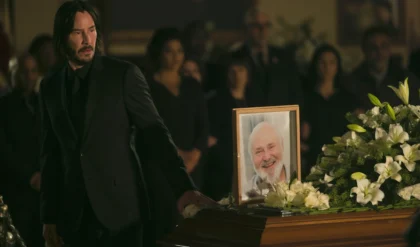“Shōgun” co-creators Rachel Kondo and Justin Marks break down Mariko’s attempted escape from Osaka.

Shōgun is a series full of wily political operators, unpredictable fight scenes, and the occasional devastating earthquake. Yet the biggest obstacle our characters have had to face is none other than a single gate leading out of Osaka Castle — a gate which becomes the focus of two of Shōgun‘s best scenes.
In episode 3, “Tomorrow Is Tomorrow,” Yoshii Toranaga (Hiroyuki Sanada) must leave Osaka in order to avoid death at the hands of Ishido Kazunari (Takehiro Hira) and the rest of the Council of Regents. His plan to make it out of the city plays like something out of a farce, complete with faked labor pains and Toranaga switching places with his wife Kiri No Kata (Yoriko Dōguchi). Ishido’s men almost catch on to the ruse, but John Blackthorne’s (Cosmo Jarvis) improvised outrage on behalf of Kiri’s virtue manages to cause enough chaos to throw them off the scent. The entire sequence is a perfect balancing act of comedy and suspense, but the next time Shōgun returns to the gate leading out of Osaka Castle, we’re in for a much more somber affair.

Anna Sawai in “Shōgun.” Credit: Katie Yu / FX
Flash-forward to “Crimson Sky,” Shōgun‘s ninth entry and its most heartbreaking to date. The whole episode focuses on Toda Mariko (Anna Sawai) as she enacts the next stages of Toranaga’s plan for victory. She arrives in Osaka and requests that she leave the next day along with Kiri and Toranaga’s consort, Shizu No Kata (Mako Fujimoto). But that request, like so many elements of Shōgun, is not as simple as it may seem. That’s because Ishido won’t let any of the nobles staying in Osaka leave. Don’t call them hostages, though! He’d prefer you think of them as very secure guests.
Mariko’s demand to leave places Ishido in a tight spot. If he doesn’t allow her to go, he’s fully confirming that everyone in Osaka Castle is a prisoner. But if he does let her go, that sets a precedent for everyone else in the castle to leave as well. He states that he and the Council will deliberate, to which Mariko retorts that if she is unable to leave the next morning, she’ll have failed to do her duty to Toranaga, and will therefore have to commit seppuku.
That takes us to Shōgun‘s second iteration of the Osaka gate scene, a tense showdown during which a determined Mariko and her retinue advance through waves of guards and archers. Eventually, she is unable to continue and resigns herself to commit seppuku later that day.
With Mariko’s seemingly inevitable death on the horizon, and with the gradual attrition of her forces grinding her to a halt, this Osaka gate scene couldn’t feel more different than Toranaga’s madcap escape in episode 3. And yet that first escape sequence is key to understanding Mariko’s attempt to leave.
“Your job is to teach the audience how to watch the show,” Shōgun showrunner, co-creator, and executive producer Justin Marks told Mashable. “Everything in episode 3 is a setup for what happens in episode 9.” Episode 3 establishes not only the architecture of Osaka Castle — including the layout of that specific gate — but also the degree of difficulty it takes to escape.
Everything in episode 3 is a setup for what happens in episode 9.





